When wondering how to breed corgis, a dog breeder must understand the differences between the two Corgi breeds: Pembroke Welsh Corgis and Cardigan Welsh Corgis. Getting involved with breeding Corgis require a comprehensive knowledge of the health issues commonly found in the breed, but also the best breeding practices.
There is no better Corgi type; it is a matter of personal preferences and which appearance do you prefer. The Welsh Corgi is one of the oldest dog breeds ever and being the Royal Dog in the United Kingdom is helping its rise in popularity. However, only one of both types is growing, the other type is stagnating at best.
Background of Corgi Breeding
Welsh Corgis are considered the oldest breed in the British Isles. Corgis can be traced back to as far as 3000 BC. These dogs more than likely have Norse ancestry. Dogs of a similar type still appear in the Scandinavian countries in the form of the current breed, the Vallhund (also called Swedish cow dog).
The name corgi can be translated from the Welsh as “dwarf dog” but there is some dispute about the name’s origin Some historians and linguists maintain that the name derives from the English word for the breed as a “cur dog”. A cur dog is a reference to the kind of work the dog performed as a heeler or herder. Cur was not derisive of the dog. Until modern times the breed worked as dogs that herded and prodded cattle along by nipping and barking at their hooves. Their short stature made it more likely that an angry cow kick would miss the working dog.
Mixed Origins
In Wales, the breed was bred in neighboring counties of Cardiganshire and Pembrokeshire. The dog in Pembrokeshire has a later ancestry than its neighboring cousin. Pembroke Welsh Corgis, as they are now known, were the progeny of dogs brought to Wales by Flemish weavers in the 10th century. Others point to a more Germanic influence with the Teckel or Dachshund being a significant ancestor. A majority will point to a bloodline with a Spitz family ancestry.
Welsh Corgis in Wales folklore were the gift from the magical fairies. These mystical creatures used the dogs to pull their coaches, and to ride upon. The markings of the mythical saddle and harness appear as markings on the dog’s back and shoulders.
One Breed, or Two?
Whatever their original origin, the types of Welsh Corgi were lumped together as one breed until the 20th century. The first Welsh Corgi clubs showed Pembroke and Cardigan dogs as a single breed. The first club in Wales in 1925 drafted a breed standard that included both types. Because the two types, Pembroke and Cardigan, had enough differences fair judging was not possible. Arguments ensued among breeders and exhibitors when the judges were thought to show bias for one or the other type. These problems were solved when the breed was recognized as two. The Kennel Club recognized the two breeds for the first time in 1934 in the United Kingdom. The American Kennel followed suit and did so in 1934 (Pembroke) and in 1935 (Cardigan).
Popularity
From the beginning, the number of Pembrokes registered outnumbered the number of Cardigans. In 1934, the Kennel Club registered 240 Pembrokes and only 59 Cardigans. In 2006, the Cardigan was placed on the Kennel Club’s List of Vulnerable Native Breeds. The Kennel Club maintains a list and tries to restore breeds of the UK that fail to register at least 300 dogs in a year. The Cardigan has been on the list since 2006! The more popular Pembroke Welsh Corgi made the list in 2014 but rebounded the next year. In 2016, the Kennel Club registered 218 Cardigans and 393 Pembrokes.
In the United States, the Welsh Corgi breed was not as popular as other breeds. Here as well, the Pembroke has been the most popular of the two. In 1997, there were more than ten times more Pembroke Welsh Corgis registered as there were Cardigan Welsh Corgis. The popularity of the Pembroke Welsh corgi was sustained in part by the admiration of British royalty. In 1933, Queen Elizabeth II as a child was given a Pembroke Welsh Corgi which she named “Dookie”. She has owned and bred them ever since. The Pembroke Welsh Corgi has had a reign of more than seventy years as the Dog of the Royal Family.
Different Types of Corgis
The Corgi’s full name is Welsh Corgi, but that’s not all since what used to be a single breed is actually two different official breeds. Although extremely similar, even in their standards wording, they have some key differences. The main dissimilarity lies in their different tails. Pembroke Welsh Corgis have a very short (docked at times) tail; while Cardigan Welsh Corgis have a naturally long tail.
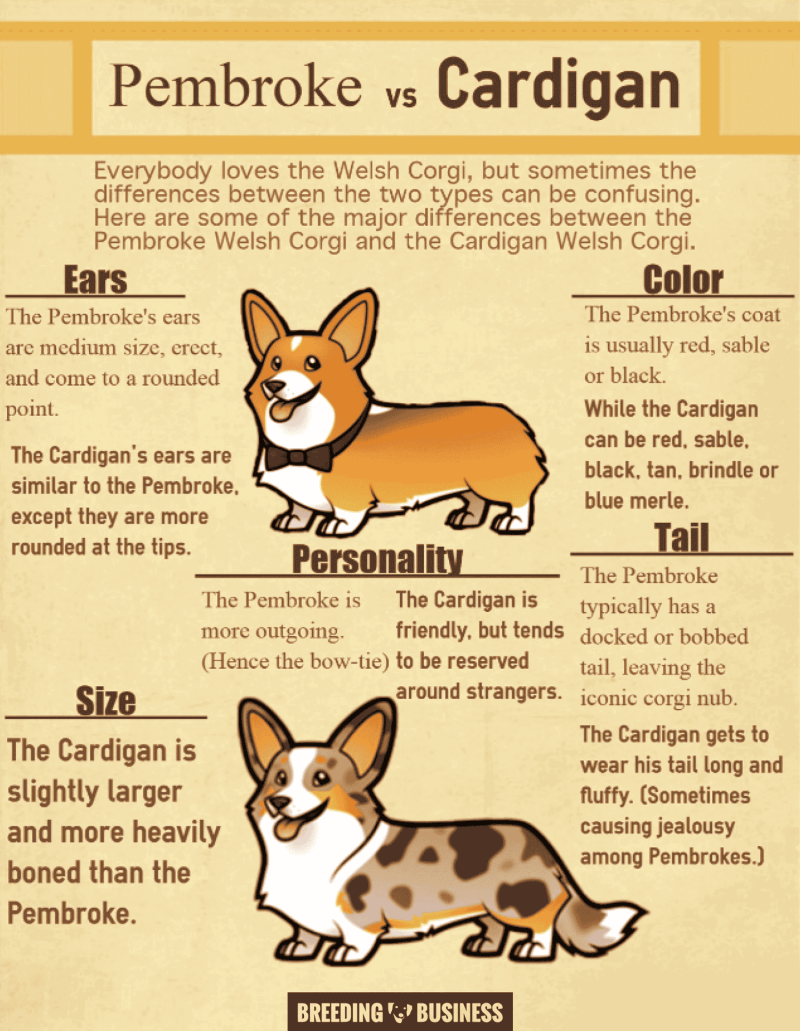
Pembroke Welsh Corgi
This breed of Welsh Corgi had its beginnings in the county of Pembrokeshire in Wales probably with the importation of a Spitz-like dog with the Flemish weavers in the 10th century. This dog was bred with the older breeds of herding dogs already found in Wales. The Pembroke Welsh Corgi served the land tenants by efficiently moving out predators in front of a herd of cattle, and by getting a cow to move by nipping and barking at its hooves. Pembroke Welsh Corgis were recognized as a breed in 1934 by both the Kennel Club and the American Kennel Club. Prior to that time, the Cardigan and the Pembroke Welsh Corgi were considered a single breed.
The AKC describes the Pembroke as a sturdy dog that is “low-set” and gives “substance in a small space”. The AKC standard for the breed requires the Pembroke Welsh Corgi to be 10 to 12 inches at the withers. The dog’s length from the withers to the base of the tail should be 40% greater than the length of the dog at the withers. The weight of the perfectly proportioned dog would be approximately 27 pounds. Dogs should not exceed 30 pounds, and bitches should not exceed 28 pounds.
The coat of the Pembroke Welsh Corgi is a double-layered coat. This top-layer of coat is subject to seasonal shedding but the standard cautions judges not to penalize for some of this hair loss. Acceptable colors include red, sable, black, and fawn. White may appear on the neck, chest, legs, underparts, muzzle, and as a narrow streak on the face. White should never be the predominant color of the dog. The dog should have brown eyes with black rims on the eyelids. Other color eyes are considered a serious fault.
The tail of a Pembroke Welsh Corgi is one of its most distinctive features. The AKC standards require a tail no shorter than 2 inches and specifically says to dock the tail. The practice of docking tails is not legal in some places. The Breed Club of Pembroke Welsh Corgis in America promotes the banding of tails of puppies at an early age to prevent the growth of the tail by cutting off the blood supply to that part of the growing dog. This nonsurgical way to shorten tails is the subject of a lot of controversies (obviously). In the UK, the Kennel Club standards prefer a naturally short tail, but docking is allowed (though docking itself was made illegal in 2006). The lack of tail is the quickest way for a person to distinguish the Pembroke Welsh Corgi from its tailed-cousin the Cardigan Welsh Corgi.
[adwithin]
The temperament of this dog is lively and active. This dog remembers it roots and will resort to herding behavior at certain times. If not properly trained, it may mistake a human foot for a cow hoof and give a slight nip to move things along. This dog is the 18th most popular dog in the 2016 AKC poll. Its popularity has hovered around the 20th spot for the last five years.
Cardigan Welsh Corgis
Fanciers of the Cardigan Welsh Corgi breed note that the breed has existed in the British Isles for 3000 years. Their job in Wales was to help with the herding of animals on the land. They were bred as a herding dog. The origins of this breed are somewhat murky. Some claim that they are related to the Teckel or Dachshund because of their size. Some seem to think that this breed of Welsh Corgi was more isolated from the incoming of the Spitz-like dogs in the 10th century. In reality, the bloodlines of the Cardigan Welsh Corgi and the Pembroke Welsh Corgi were mixed until the breed was determined to separate in the 1930s.
The AKC describes the Cardigan Welsh Corgi in much of the same language that it describes its “cousin” the Pembroke Welsh Corgi. Cardigan Welsh Corgis are also “low-set” and “sturdy”. The standards of the Cardigan Welsh Corgi require both dogs and bitches to stand 101/2 to 121/2 inches at the withers and have a length to height ratio of 1.8 to 1. The weight should be for dogs 30 to 38 pounds, and for bitches 25 to 34 pounds. Note that the Cardigan Welsh Corgi is generally a slightly larger dog than the Pembroke Welsh Corgi.
Cardigan Welsh Corgis also have a double-layered coat. They should never appear to be fluffy and strains of hair that puff out on a dog are a fault. The Cardigan has five acceptable colors including sable & white, black & white, red & white, brindle & white, blue merle & white. A predominantly white dog is a disqualifying feature.
The ears in the Cardigan Welsh Corgi are large and erect. The tips are rounded. Ears on the Cardigan Welsh Corgi are generally bigger than those of the Pembroke Welsh Corgi. The eye color should fit the coat color, but a blue eye in anything but a blue merle colored dog is a disqualifying feature.
Of course, the Cardigan Welsh Corgi stands out as a breed because they have a low set fox-like tail. The tails of this breed have never been surgically, or genetically manipulated to be shorter. The long tail has not helped their popularity, though. The Cardigan Welsh Corgi has taken second place to its Royal cousin since the breeds were recognized. There has been, nevertheless, a climb in the popularity of this breed in the last few years. In 2016, it was listed as the 69th most popular dog breed in the United States—a change from 76th the previous year.
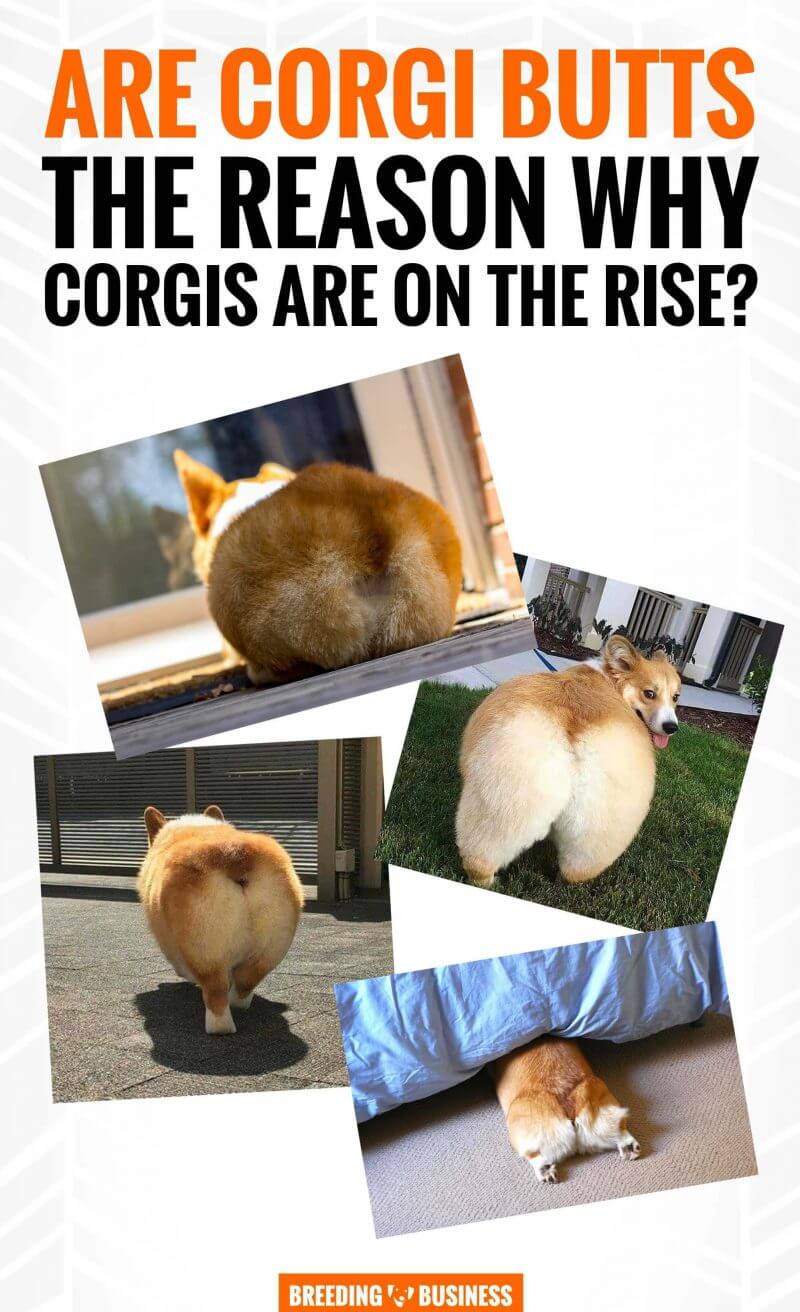
Health Concerns When Breeding Corgis
The Pembroke Welsh Corgi and the Cardigan Welsh Corgi have a lifespan of 11 to 13 years on average. They are generally healthy breeds! The OFA statistics on the breeds show that the number one concern of breeders of both breeds should be degenerative myelopathy. The Pembroke Welsh Corgi had the top position for the highest frequency of this disease. The Cardigan did not fare much better in the 11th spot.
Degenerative Myelopathy
Degenerative myelopathy is an incurable genetic disease. There is no sign of a cure for it currently. This disease strikes dogs usually around 8 years old. The dog gradually loses control of its limbs and then his bladder and bowel. The dog becomes paralyzed and dies in a process of six months to three years. No dog with this disease should be bred.
There has been a lot of research connecting the genetics of degenerative myelopathy in specific breeds. From this research, genetic testing has been developed for the disease. Both breeds of Welsh Corgi have DNA testing available for this disease. The rate of carriers for this disease was over 30% in both breeds. A breeder should insist that both dogs be cleared by genetic testing for this disease prior to mating.
[pullquote-right]The two types of Welsh Corgis (Pembroke and Cardigan) were lumped together as one breed until the 20th century. They have, since then, being split into two distinct dog breeds.[/pullquote-right]
Von Willebrand’s Disease
Von Willebrand’s disease is a genetic disease that causes excessive bleeding in dogs lacking a specific protein that is a clotting factor. Dogs that have this disease bruise easily and the disease is often noted after surgery, or when an injury occurs. Dogs that do not have medical attention could potentially bleed to death. The majority of dogs with it, nevertheless, live a normal lifespan.
This disease is caused by an autosomal recessive gene. There must be two of the genes for the disease to fully occur. Data collected by the OFA (referred above) listed the Pembroke Welsh Corgi ranked it the fifth breed with this health problem. More than a third of the Pembroke dogs tested were carriers of the gene. There are no statistics on the Cardigan Welsh Corgi breed. Its close relationship to the Pembroke Welsh Corgis in a previous age makes it likely that the breed would be susceptible to the disease.
Other health problems that crop up in these breeds are hip dysplasia, and progressive retinal atrophy (PRA). Dogs should be cleared by the OFA for both these conditions before being bred.
How to Breed Welsh Corgis
Corgis are a generally easy breed to work with, unlike other small dog breeds. This is mainly because inbreeding hasn’t been too strong over time and they are not bred to shrink their size (for now, at least.) Like every small dog breed, C-sections may be required at times.
Average Litter Size
Pembroke Welsh Corgis have an average litter of six puppies. Most breeders reported slightly larger litters of 6-8 puppies, and several factors come into play when talking about the size of a litter of puppies.
A Danish study conducted in 2010 researched litter size for 224 breeds of dogs registered in the Norwegian Kennel Club between January 1, 2006, and December 31, 2007, and found that the average litter size was 5.5. The litter size of Cardigan Welsh Corgis was about the same at an average of six.
C-Sections
Rates of c-sections have been reported to be high in the Pembroke Welsh Corgi. A comprehensive survey over a 10-year period was done in 2010 that showed Pembroke’s rate of c-section to be 37% and the Cardigan at 21.8%. These are quite high numbers. There is some indication and thought among breeders that the pelvis of Pembroke Welsh Corgi was made too narrow for a natural delivery. Other causes of the high rate in Pembrokes have to be traced to the bobtail, primary uterine inertia (which may be hereditary), and the presence of a dead puppy in the litter.
The increase in the number of cesarean sections overtime may be in part because of breeders playing it safe and electing to do a c-section if there are many big puppies seen on a pregnancy x-ray. The number of emergency c-sections is not disaggregated from the elective ones in any available study, so this assumption would be hard to confirm or infirm.
[adwithin]
Dystocia is a cause of a large number of c-sections. Breeds that have large heads in proportion to their bodies like both breeds of Welsh Corgi are at particular risk of having the problem of the dam’s reproductive tract being too small to whelp the puppy. Breeders should be available or present at the time of whelping and know when it is time to get to the veterinarian.
Stalled Labor, or primary inertia of the uterus, is a condition in which the female dog’s uterus is lazy and does not produce strong enough contractions to deliver the puppies. It is not caused by anything else such as a blocked puppy. The only solution to this problem is a c-section. The condition may be hereditary in Pembroke Welsh Corgis. Bitches whelped from dams with the problem have a much higher likelihood of having the problem themselves, if bred.
False Pregnancies
False pregnancy (or pseudopregnancy) is a condition that can happen in any bitch. It usually occurs about a month after the heat. Signs of pregnancy will occur such as enlarged mammary glands, abdominal distention, and behavioral signs like nesting and restlessness. The cause of false pregnancy is not known. The symptoms are related to an imbalance in the levels of prolactin and progesterone hormones.
A health survey conducted by the Kennel Club in 2004 listed a high percentage (18%) of Cardigan Welsh Corgis with reproductive problems including false pregnancy. However, this number was based upon very small sample size. Similarly, Pembroke Welsh Corgis, also, reported high rates (19%) of reproductive problems including irregular heat cycle, pyometra, infertility, and cryptorchid (absence of one or both testes from the scrotum). False pregnancy was not a listed problem for the Pembrokes in this study. False pregnancy is not dangerous to the bitch, but it is generally more distressing to breeders. It can be a temporary disappointment if she was, indeed, mated. In general, false pregnancies are not medically treated: they just happen. The condition resolves on its own within a few weeks.
Future of Breeding Welsh Corgis
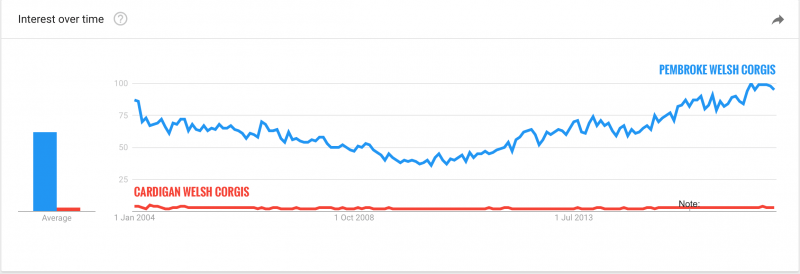
The Cardigan Welsh Corgi breeders are slowing down in numbers: the popularity of the Pembroke Welsh Corgi breed attracts most new breeders interested in the overall Corgi type of dogs. Fanciers have to do a lot of work to promote and save Cardigans; it could go one way or the other very quickly. The least popular the Cardigan is, the least breeders will want to work with it, the least puppies available, the smallest the population will be. It is a very vicious circle.
The two breeds, I believe, will carry on growing apart simply because modern times enjoy uniqueness as a general concept. We may see more and more Pembroke Corgis out there over the next years thanks to its very unique appearance. A lot of videos are going viral because of the famous and irresistible Corgi butt. The appeal is growing and it’s pretty obvious that the Pembroke breed will carry on dominating, perhaps until the end of times.
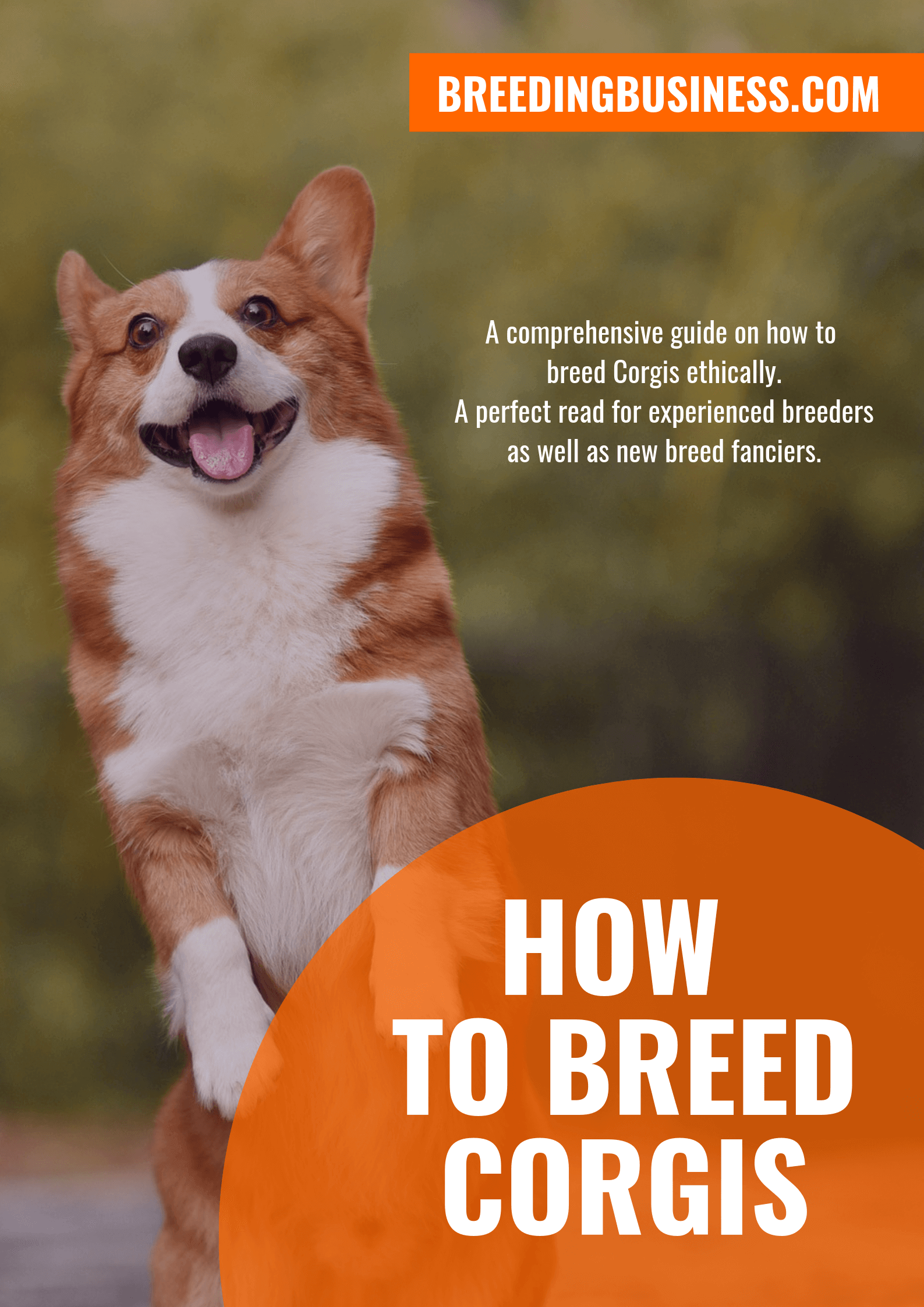
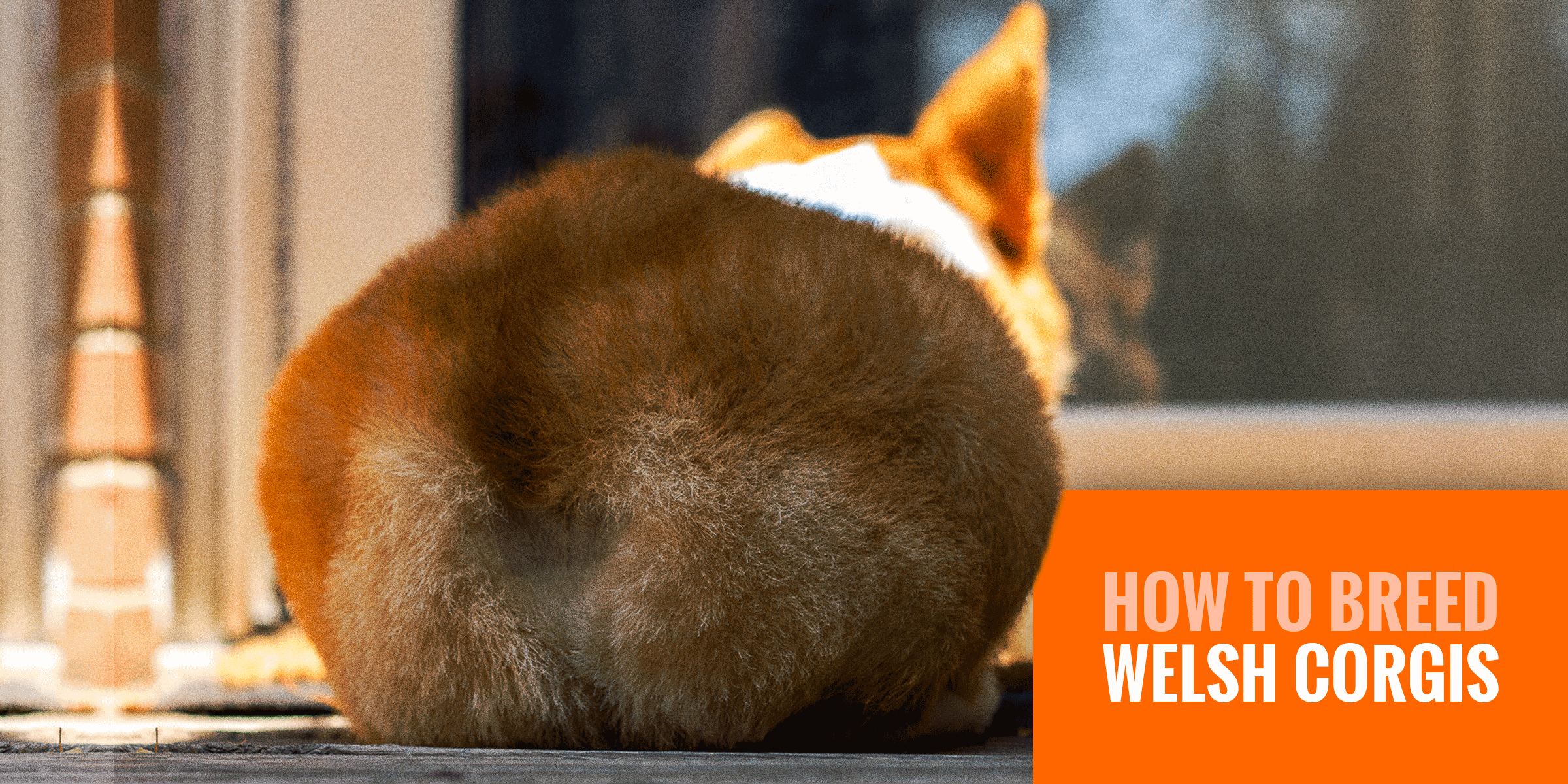
14 comments on “How To Breed Welsh Corgis – Background, Practices & Health in Breeding Corgis”
Hello,
I have a purebred Welsh Corgi in Portland, Oregon. Jetson (he) is 1-1/2 years old. I’d like to see if I could find a breeder for him. I don’t want to be the breeder. How would I go about advertising for him?
Thank you,
Thomas
Thomas, my name is Noel and i have a Pembroke Welsh Corgi female with excellent traits and am looking for a stud for her. While we live quite a way apart there are current strategies employing artificial insemination negating the dogs actually meeting. We are getting genetic testing done to ensure appropriate health and genetic traits for our breeding female. can you give me measurements to breed standards along with health checks you have performed to date along with a description of his temperament. please include things you would like enhanced or reduced in a successful pairing. Please include any stud fees or compensation for using your dog as a stud for our female. We are looking for the following traits: tri_color, or medium to dark red with full collar and an outgoing affectionate personality. No excessive aggression and of course no genetic defects that would cause problems in the pairing. I would like to discuss this further. feel free to contact us
I am looking for a Pembroke dog breeder in Northern VA. She has all of her breeding papers. She will be in heat in September 2020.
I have an adorable lil guy (Oakley) who is a year old now and I would love to find him a little girlfriend. We are in Ohio.
Hi. I’m looking for a male for my female within the next year. She is solid fawn except for the feet and the length of her underside. She has a foxy face. She is 4 months old now, but a super nice Pembroke seeming to follow the breed standard with style. Does your dog follow the standard and have no known predisposition to genetic disorders? We live in lower Michigan.
Thanks.
Amya
Sadly this article is inaccurate. The corgi breeds were NOT always lumped together. They have always been distinct. It is of course possible there was mixed breeding, but at no time in their history (other than the Kennel club still establishing itself) have they been considered the same breed, or treated as the same breed. Even when the kennel club labeled them as only corgi, the people breeding them mostly kept them separated. Most Pembroke historians will tell you that any dogs with Cardigan influence were removed from the breeding pool, and vice versa.
We are getting a pembroke, with its adorable tail intact. I think these dogs look balanced by their tails, and the tail is their way of communicating. I hope more breeders defy the AKC and opt for the more humane, and beautiful, tail!
I am looking to breed my male Pembrooke Welsh on the North Shore of Oahu, Hawaii. Austen is 3 1/2 yrs old. I would like to get one puppy out of the litter.
I am looking to breed my male Pembroke Corgi in Allen, TX he is 3 1/2 years old and has all his papers and current health records. I would like to get one pup from the litter.
We would be interested this week. We only want to breed our sweet girl one time, and we can either pay a fee or pick of litter. We live in your area. She is in heat and would need to have her play date this week as this will be the first and final.
Is it acceptable to breed a Red Pembroke to another Red Pembroke or a Tri to another Tri? IF not, what are the concerns? Thank you.
Yes I know a Corgi breeder who routinely books Cesars for her girls because of this.
This article has allot of good information. Being a corgi breeder for over 30 years, it can be very rewarding if you’re up to the challenge. The best advice I can give one considering breeding their corgi is this…Corgis are one of the top 5 breeds that require a c-section. Not all corgis require them, but I have had many instances where the momma and I were already at the 20 hours of labor mark and the very last puppy is stuck. So here you are 3 am in the morning headed to the vet for an emergency c-section. Allot of vets don’t do emergencies and allot of the emergency vet clinics don’t do c-sections. This is all stuff that needs to be taken into consideration and planned way in advance. You must have your vet prepared to be on call or schedule your c-section and not put your momma thru 20 hours or more of labor and take the chance something will go wrong.
This article has allot of good information. Being a corgi breeder for over 30 years, it can be very rewarding if you’re up to the challenge. The best advice I can give one considering breeding their corgi is this…Corgis are one of the top 5 breeds that require a c-section. Not all corgis require them, but I have had many instances where the momma and I were already at the 20 hours of labor mark and the very last puppy is stuck. So here you are 3 am in the morning headed to the vet for an emergency c-section. Allot of vets don’t do emergencies and allot of the emergency vet clinics don’t do c-sections. This is all stuff that needs to be taken into consideration and planned way in advance. You must have your vet prepared to be on call or schedule your c-section and not put your momma thru 20 hours or more of labor and take the chance something will go wrong. Just food for thought.